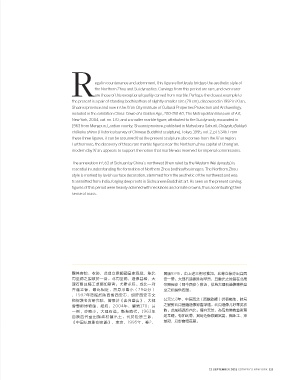Page 133 - September 11 2018 Junkunc Collection Sculpture
P. 133
egal in countenance and adornment, this figure effortlessly bridges the aesthetic style of
the Northern Zhou and Sui dynasties. Carvings from this period are rare, and even rarer
Rare those of this exceptional quality carved from marble. Perhaps the closest example to
the present is a pair of standing bodhisattvas of slightly smaller size (79 cm), discovered in 1992 in Xi’an,
Shaanxi province and now in the Xi’an City institute of Cultural Properties Protection and Archaeology,
included in the exhibition China: Dawn of a Golden Age, 200-750 AD, The Metropolitan Museum of Art,
New York, 2004, cat. no. 170; and a smaller marble figure, attributed to the Sui dynasty, excavated in
1963 from Mengcun, Lantian county, Shaanxi province, published in Matsubara Saburō, Chūgoku Bukkyō
chōkoku shiron [Historical survey of Chinese Buddhist sculpture], Tokyo, 1995, vol. 2, pl. 534b. From
these three figures, it can be assumed that the present sculpture also comes from the Xi’an region.
Furthermore, the discovery of these rare marble figures near the Northern Zhou capital of Chang’an,
modern day Xi’an, appears to support the notion that marble was reserved for imperial commissions.
The annexation in 553 of Sichuan by China’s northwest (then ruled by the Western Wei dynasty) is
essential in understanding the formation of Northern Zhou bodhisattva images. The Northern Zhou
style is marked by lavish surface decoration, stemmed from the aesthetic of the northwest and was
transmitted from India, forging deep roots in Sichuanese Buddhist art. As seen on the present carving,
figures of this period were heavily adorned with necklaces and ornate crowns, thus accentuating their
sense of mass.
㻭ڣღ䆹Ƞ㶐丫喑ₑᄷ⿸䵄䶜⮴უ䷕ح喑䯳ࡄ ృ❵534bȡ⩞̷䔝̶Ҹजᣕⴒ喑ₑᄷ⿸ϓܧ㜗㺬
ক㜠䮸䴨㜡̭䏘ȡࡄক㜠䮸喑䕍⩇⼭喑๔ Ⴖ̭፣ȡ๔⤳ⴠ䕍₷◧㒂㺸喑́䛺ٶౝ⮳ౕࡄক
⤳ⴠ䰂́ጒࢀ㊂ຯ㔲喑ᅑ䰐Ⅿᓄȡᝃ℁̭ᄺ ፊ䬂䪤Ⴖ喍ࢠϷ㺬Ⴖ喎䭱䓾喑ѩ◧๔⤳ⴠ䕍ᄵӈ⮴
㤖㫖⿸喑ᰭ◧Ⱕ䓾喑♣䏘ᒏ⪒ᄼ喍79ڙܳ喎 ბ㿗ӈѽ䁶ȡ
喑1992Ꭱ⮩ᣅ䮊㺬Ⱞ㺬Ⴖጯ喑⤫䇜㺬Ⴖጯ᪴
ڙٰ553Ꭱ喑͚࣌㺬ࡄ喍㺬偼ᩬ‷喎Ңो㰭ౝ喑᭯ᅭ
➖Ԋ䂤㔰ऑⵁ⾣䮏喑ᰫᆂȨ䊝ाⰈȩ喑๔䘪
䂷ᄺࡄক㤖㫖䕍ᒞ䴬⌞䖍ȡࡄক䕍ᅑສ㤜㒻㶐
ᰰ㬊㶀ࢇ➖乕喑㈽㈱喑2004Ꭱ喑㌕㮌170喠ओ
丫喑ₑ䷕ᵩ⎽㺬ࡄ喑נ㜗๖〧喑◧㰭ౝ҈᪆㬊㶀ຍ
̭Ҹ喑ϓ⪒ᄼ喑๔⤳ⴠ䕍喑◧䮸А喑1963Ꭱ
Ⴧധ⸻ȡᰶຯₑᄷ喑ڣ᭯䕍⾬ᝡჹ叄喑Җ⤍⢶Ƞ
㜗 䮊 㺬 Ⱞ 㫺 ⩝ ㍐ ႌ ᱾ 䣛 ܧ ౌ 喑 ܷ Ძ ࣌ ̶ 䗻 喑
㤜ۍ喑ВᒝᄣⰥ㢷ȡ
Ȩ͚పϼ᪆ᒘݨट䀃ȩ喑Პϙ喑1995Ꭱ喑ࢤ2喑
12 SEPTEMBER 2018 SOTHEBY’S NEW YORK 131

